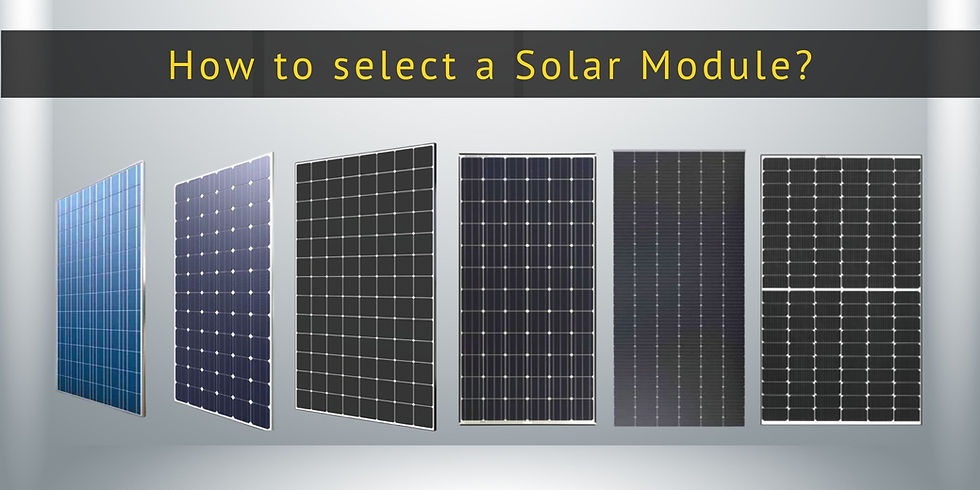New Solar Policy in TamilNadu
- Cares Renewables

- Nov 30, 2021
- 3 min read
Tamil Nadu government had announced an amendment to their roof-top solar policy on the 20th of October 2021. In this blog, we will discuss the new policy and its impact on roof-top solar installations.

Summary
The solar policy amendment defines a metering mechanism for solar installations up to 999 kW for LT and HT customers. (Please read our old blog to understand the difference between net-metering, gross-metering and net-feed in tariff metering mechanisms). The policy introduces Net Work (grid-support charges) for all metering mechanisms except gross-metering. While the Net-metering scheme will boost solar installations among residential customers, the proposed grid-support charge will be a burden for all HT customers. TNERC will revise the net-work charges and the feed-in tariff from time to time.

Solar Policy Impact on Roof-top Installations
To completely understand the Solar Policy, let us look at how it will impact different consumer categories:
LT Residential Solar Installation
An LT residential consumer will be eligible for a net-metering scheme. For a residential customer with electricity bill of more than 5000, who wants to install up to 10 kWp solar power plant, net-metering will be an attractive option:
Let us assume that a homeowner's bimonthly energy consumption is 2000 units (If we use, TNEB Bill calculator https://www.tnebnet.org/awp/tariffMaster?execution=e3s1, this comes to an electricity bill of 11,680). He installed a Solar Power Plant of 8 kWp capacity that produced 1900 units during the same period. How will he be billed under the new regime? The calculation is fairly simple:
Net-consumption = (2000 - 1900) = 100 units
Net Work (Grid Support) Charges = INR 1,900 * 20% * 1.27 = INR 482.6
Charges for 100 units = 0 (in Tamil Nadu)
Net-Bill for the End Customer = INR 482.6 + (Fixed Charges, if any, may be 30 Rs)
Please note that for LT domestic customers above 10 kWp, the Net-Work charges is higher at 80% of INR 1.27 per unit.
Happy News !!
LT domestic consumers who have gone solar with net-feed in tariff in the existing regime can switch to net-metering and avail benefits of net-metering as per the new policy.
LT Commercial Solar Installation
For commercial and other LT customers, the billing mechanism is net-feed in tariff, which is a bit more tricky (Please read our blog on the difference between net-metering, net-feed in tariff and gross-metering to understand what is self-consumption, import and export) :
Let us assume that a commercial complex owner's monthly energy consumption is 1000 units (An electricity bill of 9,153). He installed a Solar Power Plant of 8 kWp capacity that produced 950 units during the same period. How will he be billed under the new regime?
The commercial complex owner will be eligible for net-feed in tariff with net-work charges of 1.27 Rs per unit:
Let us assume that the commercial customer has a self-consumption of solar of 700 units, and is exporting 250 units to the grid.
Electricity Bill for 300 units drawn from TNEB as consumption = INR 3236 (as per bill calculator of TNEB)
Net Work charges for Solar Production =1.27*950 = INR 1206.50
Reduction in Bill due to Feed-in Tariff = 250*3.61 = INR 902.5
Net-Bill to be paid by customer to TNEB = INR 3236 + INR 1206.50 - INR 902.5 = INR 3,360
As you might have noticed, the net savings to the customer is low because of the feed-in tariff billing mechanism and the newly introduced Net Work charges. However, considering the reliability and long-term benefit of Solar Installation, the policy clarity may encourage more commercial business owners, and educational institutions to go Solar.
Please note that for LT customers above 10 kWp, the feed-in tariff is lower at INR 3.37 per unit.
HT Solar Installation
For HT customers also the billing mechanism is net-feed in tariff, and the calculations will be similar. The only difference is that the net-feed in tariff (INR 3.10/unit) and the Net-Work charges (INR 0.83/unit) are fixed at a lower rate.
Compliance is Mandatory
As per the amendment, TNEB is not going to allow behind the meter connection of Solar without net-metering/Net Work Charges. The compliance will be enforced retrospectively, and all existing HT customers who are availing benefits of Solar through behind the meter installations will have to convert to the new metering mechanisms. This will hurt factories that consume more than 90% of solar generation through self-consumption.
This blog is written based on our interpretation of the Solar Policy, and is not a complete representation of all contents in the policy document. Please inform us, if you find any flaws in the blog content. At Cares Renewables, we are focused on delivering quality solar solutions to our customers and partners. Please leave a comment, if you have any queries on this blog. Write to us at info@caresrenewables.com, for your solar requirement.




Comments